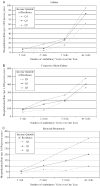Physician visits, hospitalizations, and socioeconomic status: ambulatory care sensitive conditions in a canadian setting
- PMID: 16033498
- PMCID: PMC1361193
- DOI: 10.1111/j.1475-6773.2005.00407.x
Physician visits, hospitalizations, and socioeconomic status: ambulatory care sensitive conditions in a canadian setting
Abstract
Objective: To determine whether rates of physician visits for ambulatory care sensitive (ACS) conditions are lower for people of low-socioeconomic status than of high-socioeconomic status in an urban population with universal health care coverage.
Data sources/study setting: Physician claims and hospital discharge abstracts from fiscal years 1998 to 2001 for urban residents of Manitoba, Canada. The 1996 Canadian Census public use database provided neighborhood household income information. The study included all continuously enrolled urban residents in the Manitoba Health Services Insurance Plan.
Study design: Twelve ACS conditions definable using 3-digit ICD-9-CM codes permitted cross-sectional and longitudinal comparison of ambulatory visits and hospitalizations. Neighborhood household income data provided a measure of socioeconomic status.
Data collection/extraction methods: Files were extracted from administrative data housed at the Manitoba Centre for Health Policy.
Principal findings: All conditions showed a socioeconomic gradient with residents of the lowest income neighborhoods having both more visits and more hospitalizations than their counterparts in higher income areas. Six of nine conditions with a sufficient N showed individuals living in the lowest income neighborhoods to have significantly more ambulatory visits before hospitalization for an ACS condition than did those in the most affluent neighborhoods. Many conditions showed a gradient in rate of hospitalization even after controlling for the number of ambulatory care visits.
Conclusions: In the Canadian universal health care plan, the poor have reasonable access to ambulatory care for ACS conditions. Ambulatory care may be more effective in preventing hospitalizations among relatively affluent individuals than among the less well off.
Figures
Comment in
-
The persistent challenge of avoidable hospitalizations.Health Serv Res. 2005 Aug;40(4):953-6. doi: 10.1111/j.1475-6773.2005.00442.x. Health Serv Res. 2005. PMID: 16033486 Free PMC article. No abstract available.
References
-
- Anderson RT, Sorlie PD, Backlund E, Johnson NJ, Kaplan GA. “Mortality Effects of Community Socioeconomic Status.”. Epidemiology. 1996;8(1):42–7. - PubMed
-
- Backus L, Moron M, Baccetti P, Baker LC, Bindman AB. “Effect of Managed Care on Preventable Hospitalization Rates in California.”. Medical Care. 2002;40(4):315–24. - PubMed
-
- Basu J, Friedman B, Bursten H. “Primary Care, HMO Enrolment and Hospitalization for Ambulatory Care Sensitive Conditions: A New Approach.”. Medical Care. 2002;40(12):1260–9. - PubMed
-
- Billings J, Anderson GM, Newman LS. “Recent Findings on Preventable Hospitalizations.”. Health Affairs (Millwood) 1996;15(3):239–49. - PubMed
-
- Billings J, Zeitel L, Lukomnik J, Carey TS, Blank AE, Newman L. “Datawatch: Impact of Socioeconomic Status on Hospital Use in New York City.”. Health Affairs (Millwood) 1993;12(1):162–73. - PubMed
Publication types
MeSH terms
LinkOut - more resources
Full Text Sources


